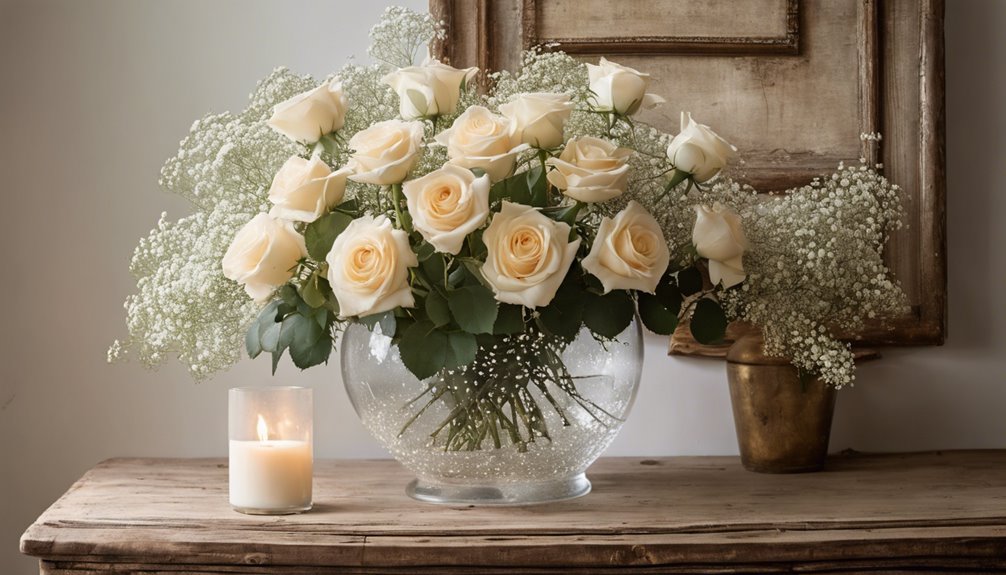You can elevate your space by thoughtfully selecting flowers that resonate with your personal style and complement the room's unique character. Consider the meaning, freshness, and style of flowers like sunflowers, which symbolize warmth and happiness, or peonies, which represent good fortune and prosperity. Choose vases that enhance the space and flowers, like glass for a modern look or ceramic for a cozy feel. By balancing colors, textures, and scale, you can create a striking centerpiece that draws the eye. Now, discover how to craft stunning arrangements that reflect your style and transform your home.
Choosing the Right Flowers
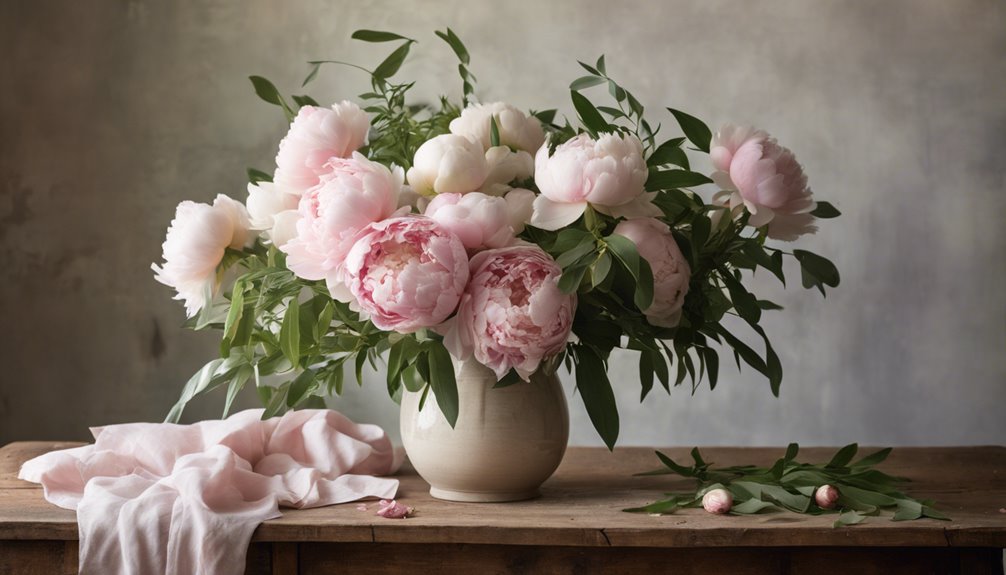
When selecting flowers to adorn your space, you're not just picking a pretty face – you're choosing a mood-setter, a conversation starter, and a reflection of your personal style. Fresh bouquets can instantly elevate the ambiance of a room, but making certain to examine the meanings behind each bloom is crucial. Sunflowers, for instance, symbolize warmth and happiness, while peonies represent good fortune and prosperity. Opt for seasonal flowers to guarantee they're at their peak freshness and vibrancy. Weigh the colors and textures you want to incorporate into your space, and choose flowers that complement them. By thoughtfully selecting your flowers, you'll create a harmonious and inviting atmosphere that reflects your unique taste and personality.
Essential Vases and Containers
Your flowers are chosen, and now it's time to give them a beautiful home. You'll want to select vases and containers that complement their beauty and enhance your space. Consider vase materials like glass, mercury glass, or ceramic, each offering a unique aesthetic. Glass vases provide a clean, modern look, while mercury glass adds a touch of elegance. Ceramic vases bring warmth and coziness to your arrangement. Container shapes also play a vital role. Round vases soften angular spaces, while rectangular ones create a sense of structure. Experiment with different shapes and materials to find the perfect pairing for your flowers.
Mixing and Matching Colors
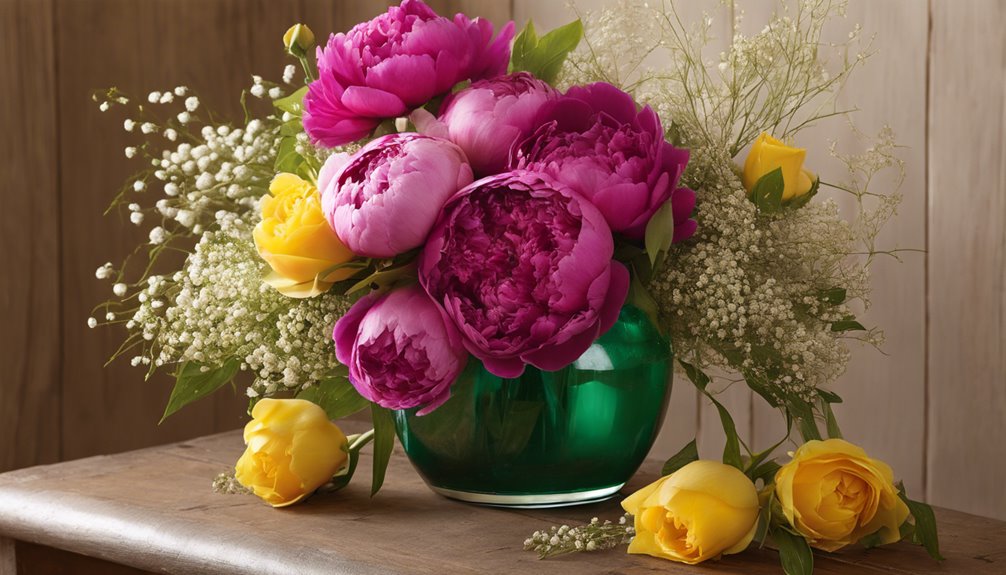
Now that you've chosen the perfect vase or container, it's time to think about the colors that'll bring your arrangement to life. Mixing and matching colors can be intimidating, but with a few simple principles, you'll be a pro in no time. Consider color blocking, where you group flowers of similar hues together for a bold statement. Alternatively, opt for monochromatic harmony, where you use different shades of the same color to create a cohesive look.
| Color Scheme | Description | Emotional Response |
|---|---|---|
| Monochromatic | Soft peach and blush tones | Whimsical, romantic |
| Analogous | Blues and purples with a touch of green | Calming, soothing |
| Complementary | Vibrant oranges and blues | Energizing, playful |
Creating a Focal Point
A well-crafted flower arrangement is all about directing the viewer's eye to a central point of interest, and that's where creating a focal point comes in. You want to draw attention to a specific area of your space, whether it's a coffee table, dining table, or mantel. To do this, create a statement centerpiece that incorporates bold, eye-catching flowers and unique floral accents. This will serve as the anchor of your arrangement, pulling the viewer's eye towards it. Consider using a show-stopping vase or container to add an extra layer of visual interest. By creating a clear focal point, you'll add depth and visual appeal to your space, making it feel more inviting and stylish.
Adding Greenery for Texture
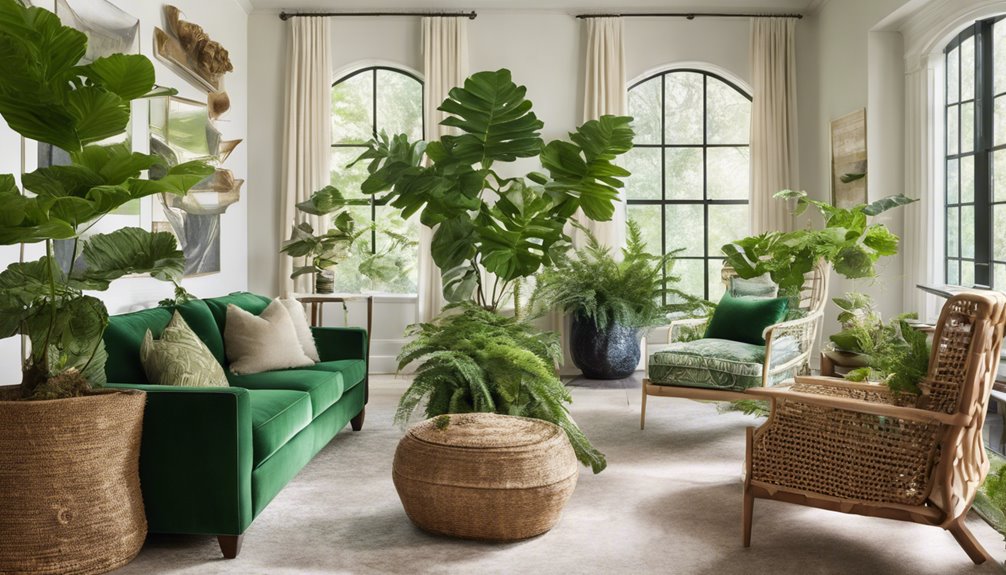
As you arrange your flowers, consider combining different foliage types to add depth and visual interest. You'll want to balance scale sizes, pairing delicate ferns with larger, statement leaves, and contrasting leaf shapes, like rounded succulents with spiky cacti, to create a dynamic display. By mixing and matching these elements, you'll craft a richly textured arrangement that draws the eye.
Mixing Foliage Types
You'll find that combining different foliage types creates a visually intriguing arrangement, especially when you balance contrasting textures. By mixing leaf textures, such as velvety eucalyptus, smooth ferns, and fuzzy lamb's ear, you'll add depth to your arrangement. Create foliage layers by pairing delicate, lacy greens like ferns or queen anne's lace with thicker, more structured leaves like succulents or hostas. This contrast will draw the eye through the arrangement, creating visual interest. Don't be afraid to experiment with different combinations – the key is to balance contrasting textures and create a harmonious visual flow. By doing so, you'll create a stunning, one-of-a-kind arrangement that showcases your unique style.
Balancing Scale Sizes
This thoughtful balance of scale sizes is what takes your arrangement from ordinary to extraordinary, and it starts with adding greenery for texture. By combining different sizes of flowers and foliage, you create scale harmony, drawing the eye through the arrangement. Visual weights play a pivotal role in achieving this balance. Large, statement flowers or branches serve as anchors, while smaller elements provide a sense of airiness. Don't be afraid to mix and match different textures, from delicate ferns to robust succulents, to add depth and interest. As you arrange, step back and assess the overall visual flow, adjusting the scale and texture to create a sense of harmony that invites the viewer in.
Contrasting Leaf Shapes
When incorporating greenery for texture, don't overlook the impact of contrasting leaf shapes, which can add a mesmerizing layer of visual interest to your arrangement. You'll be amazed at how varying leaf shapes can elevate your design. Mix smooth, rounded leaves with pointed, angular ones to create a visually appealing contrast. For example, pair velvety eucalyptus leaves with spiky fern fronds or delicate ferns with bold, waxy leaves. This foliage contrast will add depth and dimension to your arrangement. Experiment with different leaf variations to find the perfect blend for your space. By incorporating contrasting leaf shapes, you'll create a stunning, one-of-a-kind design that showcases your unique style.
Balancing Flowers With Decor
As you bring flowers into your space, you'll want to strike a balance between their vibrant colors and the existing decor. Consider mixing flower colors to complement or contrast with the hues in your furniture, rugs, and artwork. By choosing vase styles that echo the lines and textures of your decor, you'll create a harmonious focal point that draws the eye.
Mixing Flower Colors
A dozen or so flowers in a vase can create a stunning centerpiece, but it's the deliberate choice of flower colors that elevates the arrangement from mere decoration to a work of art. When mixing flower colors, you'll want to ponder color harmony. Monochromatic, complementary, and analogous color schemes can create visually appealing arrangements. For a bold statement, try pairing bright flowers with neutral accents. For a softer look, combine pastel shades with greenery. Don't forget to incorporate a floral accent, like a single statement bloom or a sprig of foliage, to add depth and interest. By thoughtfully selecting flower colors, you can create a stunning arrangement that complements your home's décor and makes you feel like a true designer.
Choosing Vase Styles
Your vase choice can make or break the overall aesthetic of your floral arrangement, so it's essential you select one that complements the flowers and your home's décor. A vase that clashes with your flowers or surroundings can detract from the overall beauty of the arrangement. Consider the style and atmosphere you want to create in your space.
| Vase Style | Description | Suggested Flowers |
|---|---|---|
| Vintage charm | Distressed, ornate, and classic | Soft peonies, romantic roses |
| Modern sleek | Clean lines, minimal ornamentation | Structured calla lilies, architectural succulents |
| Whimsy accents | Playful, colorful, and ornate | Bright sunflowers, daisies with varied petals |
Choose a vase that resonates with your personal style and the atmosphere you want to create. This will guarantee your flowers look stunning and your space feels cohesive and inviting.
Focal Point Creation
Three key elements come together to create a stunning focal point in your space: the flowers, the vase, and the surrounding decor. To strike a balance, consider the colors and textures of each component. Your flowers should complement the hues in your room, while the vase adds a touch of elegance or whimsy. The surrounding decor, such as throw pillows or wall art, should enhance the overall aesthetic. Don't be afraid to add floral accents, like greenery or berries, to create depth and visual interest. A statement piece, like a bold-colored vase or an oversized bouquet, can draw the eye to the focal point. By harmoniously blending these elements, you'll create a beautiful, Instagram-worthy arrangement that makes you feel proud to call your space home.
Seasonal Flower Arranging Ideas
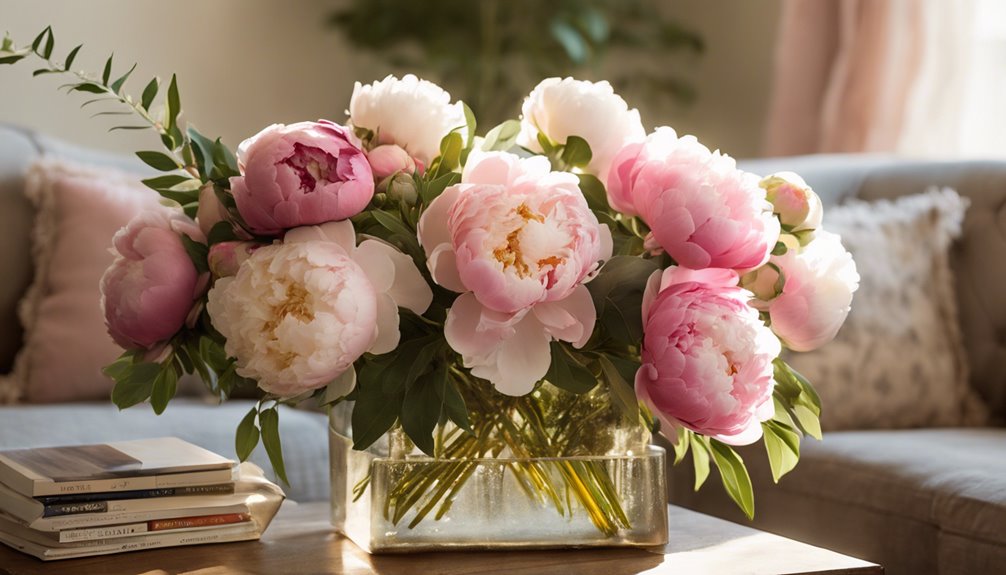
As winter's chill begins to thaw, or summer's warmth starts to wane, the flowers in your arrangements should shift to reflect the season's unique character. You can create stunning displays that evoke the essence of each time of year. Here's how:
- Winter Blooms: Incorporate evergreen branches, holly, and festive red berries into your arrangements to capture the magic of the season.
- Spring Bouquets: Welcome warmer days with vibrant tulips, daffodils, and hyacinths in pastel shades that mirror the season's soft hues.
- Summer Florals: Bring the outdoors in with sun-kissed blooms like sunflowers, zinnias, and cosmos in bold, bright colors.
- Autumn Accents: Add warmth with rich, earthy tones from flowers like chrysanthemums, dahlias, and asters, paired with seasonal fruits and foliage.
Frequently Asked Questions
How Often Should I Change the Water in My Flower Arrangements?
As you gaze at your blooms, remember: you're the guardian of their fleeting beauty. Change the water every 2-3 days to certify flower freshness and prevent bacterial growth, guaranteeing crystal-clear water quality that makes your arrangements shine.
Can I Use Artificial Flowers in My Decor?
You can totally use artificial flowers in your decor, and with high-quality blooms, no one will even notice! Choose arrangements that mimic natural styles, like loose, organic bunches or structured, elegant centerpieces, to elevate your space's visual appeal.
Are There Any Flowers That Are Toxic to Pets?
As a pet owner, you're prudent to ponder the perils of poisonous petals. Lilies, azaleas, and daffodils can be deadly, so opt for pet-friendly flower alternatives like roses, sunflowers, or orchids to guarantee a safe and stunning space that's welcoming to all.
How Do I Keep My Flowers From Wilting Quickly?
To keep your flowers fresh, you'll want to master flower freshness tips like changing the water daily and using a floral preservative. Also, try stem trimming techniques like cutting at an angle to increase water uptake and prevent blockages.
Can I Reuse Flowers From an Old Arrangement?
You can breathe new life into old blooms through flower recycling! Gently remove wilted petals, trim stems, and refresh the arrangement with new flowers, foliage, or greenery to create a stunning, one-of-a-kind piece that's uniquely yours.

